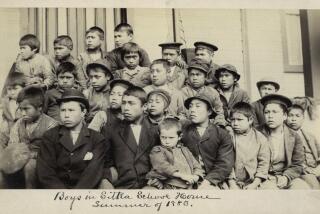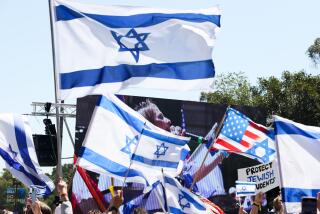Internment Lesson Plan Is Under Attack
BAINBRIDGE ISLAND, Wash. — More than six decades ago, this tranquil island in Puget Sound became roiled in conflict after hundreds of Japanese American residents were forced off the island into World War II internment camps. Neighbors argued, sometimes violently, over the rightness of targeting an entire population based on race.
The argument has surfaced here again, this time over a sixth-grade social studies program that teaches, among other things, that the internment of 110,000 to 120,000 Japanese Americans in the 1940s was a mistake.
A group of residents is demanding that the school board change the program so that it includes different opinions, including the view that the internment was justified. The group also wants to omit discussions that hint at parallels between the internment and the U.S. Patriot Act. Some members say they are prepared to pursue legal action, if necessary.
School officials would consider making “refinements” to the program, but “the basic tenor would remain the same,” said Bruce Weiland, president of the Bainbridge Island School Board. The overall message would continue to be that “the internment was a mistake, that it was illegal and it was a tragedy.”
Weiland and others said that view was shared by most scholars and the U.S. government, which issued a formal apology and reparations to surviving internees. For many supporters of the program, the debate has long been settled.
The new conflict began after a social studies teacher at Sakai Intermediate School (named after a local man who was interned) won a $17,000 state grant to teach about the internment and how it affected the residents of Bainbridge Island, which is a half-hour ferry ride from Seattle and has a population of about 20,000.
The program, called Leaving Our Island, was first taught in February as part of a U.S. history class. Students went to a museum, wrote haiku, built an internment barracks and interviewed local Japanese Americans who had been evacuated. The program was supposed to last two weeks, but instead went on for about a month.
Early this year, some parents expressed concern that too much time was being devoted to only one aspect of the war. Private discussions between parents and teachers continued through the year. As preparations were being made this summer for the start of the new school year, the discussions heated up.
A handful of parents aired their concerns at a school board meeting late last month, and the group attracted others, including some World War II veterans, as news of the rift spread. A public meeting Thursday drew a capacity crowd and elicited an outpouring of arguments for and against the program. The majority of the estimated 40 speakers expressed support. But opponents drew the most attention.
“I firmly believe that the teaching unit in question rises to the level of propaganda,” said Mary Dombrowski, who has a daughter in the sixth grade. The program, she told the board, must “allow students to hear from those who believe that internment was not a mistake.”
Dombrowski cited a current bestselling book that defended the internment, in part because the government believed at the time that there was a network of Japanese spies on the West Coast. (A recent statement signed by 39 historians and researchers, including faculty from Stanford and Harvard universities, called the book “distorted” and “historically inaccurate.”)
Dombrowski said she had received many calls of support from the island and all over the country, but that many were afraid to come forward.
Resident James Olsen called the program “an example of an agenda-based curriculum that is designed to lead our 11-year-old Sakai students to hate America.”
Olsen said the school’s policy dictated that discussions of controversial subjects must include opposite viewpoints. “A demand will be made that they adhere to their stated process of dealing with controversial issues,” he said. “Otherwise, steps can be taken. School districts and school boards sometimes find themselves in court.”
Many supporters expressed incredulity that the issue was being debated. “To me, the debate has already come to a conclusion,” said Clarence Moriwaki, a member of Bainbridge’s Japanese American community.
Moriwaki, who heads a group that is working on building a $4-million memorial to the island’s internees, said some ideas, such as slavery, are no longer debatable.
“No reasonable person today believes it’s justified to have people as property,” he said. The internment of thousands of American citizens who did nothing wrong “is the same kind of thing: it is no longer justifiable.”
Japanese began immigrating to the island in the late 19th century, working as laborers, mill workers and farmers. At the outset of World War II, Bainbridge had a thriving Japanese American population.
Executive Order 9066, enacted by President Franklin D. Roosevelt shortly after the Japanese bombing of Pearl Harbor, was deemed a military necessity to protect against domestic espionage and sabotage.
On March 30, 1942, between 227 and 270 (the numbers are disputed) Japanese Americans on the island became the first group in the nation to be evacuated. Families were split. Many lost livelihoods, homes and their life savings. Most of the Bainbridge evacuees were sent to Manzanar War Relocation Center, a camp near California’s Mojave Desert.
In 1976, President Gerald Ford declared the evacuation wrong.
A federal commission in 1983 concluded that the internment of Japanese civilians, two-thirds of them born in the United States, was “motivated largely by racial prejudice, wartime hysteria and a failure of political leadership.”
In 1988, President Ronald Reagan signed a bill that awarded $1.2 billion in reparations to about 60,000 surviving detainees, who received about $20,000 each. The bill also set up a $1.25-billion trust fund. Presidents George H.W. Bush and Bill Clinton issued formal apologies to survivors.
More to Read
Sign up for Essential California
The most important California stories and recommendations in your inbox every morning.
You may occasionally receive promotional content from the Los Angeles Times.










